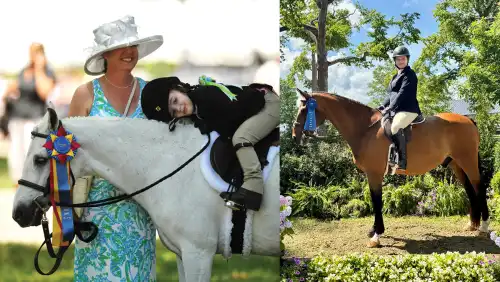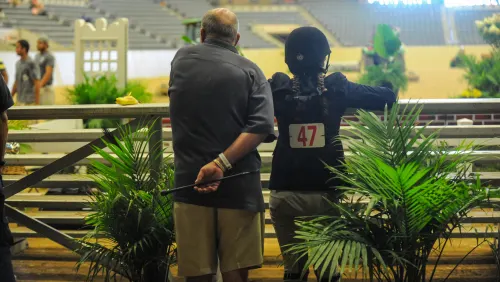Mexico and the Olympics
Thomas Clyde
June 27, 1948
When Humberto Mariles-Cortes of Mexico trotted into Wembley Stadium [in London] on his famous bay Arete, he shouldered a nerve wracking responsibility. He was the last rider on the Mexican team and the last competitor of 44. The Mexicans could afford 28 faults to beat Spain.
But although Cortes had this fair margin, he had to complete the course or his team would be
disqualified.
That was not all. No one had jumped a clear round and three riders were tied for first place with eight faults apiece–[Jean] d’Orgeix of France, [Col. Franklin] Wing of the U.S.A., and [Capt. Ruben] Uriza of Mexico.
[When Cortes rode] such was the tension in the crowd that it felt as if 82,000 people were instinctively lifting the horse and rider. [After clearing the final fence] a thunderclap of applause echoed round and round that mighty oval in just recognition of a great horse and horseman. With 21³2 time faults for a total of 61³2, Cortes was the winner.
U. S. Equestrian Teams At Helsinki
August 8, 1952
The months and years have rolled along rapidly since a group of people made a momentous decision–the U.S.A. would be represented in the equestrian events in the 1952 Olympic Games. Meetings had been held and much talk had been involved.
ADVERTISEMENT
Hard work by the sponsors, committees, horsemen and horse shows was more than repaid by the whole exhibition of the Individual Dressage, Three Day Event, and Prix des Nations representation at the 1952 Olympic Games, which came to a close at Helsinki, Finland, on August 3.
Represented for the first time by a civilian-sponsored team, the U.S. had great hopes when after the morning session of the Prix des Nations was over, Major John Russell and the veteran Army horse Democrat were leading, but the pace proved too much for the aged gelding and that afternoon he had four knockdowns. Great Britain accounted for its only gold medal during the games, over the Chilean team. The U.S. team composed of Arthur McCashin on Miss Budweiser, William Steinkraus on Hollandia, and Maj. Russell finished third.
Olympic Prix Des Nations
Alexander Mackay-Smith
September 30, 1960
As the shadows moved across the greensward and gaily painted fences in the center of Rome’s Olympic Stadium, a bay Thoroughbred mare tiptoed down the ramp beneath a pink coated rider. The crowd, which filled every seat and aisle of the arena, suddenly hushed with anticipation. For this was Halla, the great Halla, who with Hans-Gunter Winkler had won virtually every international jumping event in the world, turning in a perfect second round to win the 1956 Olympic Gold Medal when her rider, groaning with pain from a rupture sustained during the morning round, was just a passenger.
Now if Halla and Winkler could produce a good round, the Gold Medal would be theirs. [Heading to the last], the biggest spread of all, theirs looked like the only clean round of the 101 turned in that day, but the far pole came down. The deafening applause which followed the pair conveyed nothing new. When Winkler relaxed before the final fence, Halla knew they already had the points–that Germany had won the medal.
The Bronze Medal Ends
16-Year Drought
John Strassburger
August 21, 1992
Ever since the famous team of Hilda Gurney, Dorothy Morkis and Edith Masters won the bronze medal at the 1976 Montreal Olympics, Americans have been hoping and waiting for a repeat performance in the dressage arena.
ADVERTISEMENT
That’s why Robert Dover, who’s lived through all those unfilled hopes as a team member, steadfastly refused to officially predict an outcome in the days before Barcelona.
Carol Lavell was more openly optimistic, and after the first day, when the U.S. team was a close fifth, she stated, “We surrender to the Germans but not to the Dutch yet.”
O’Connor Raises His Own U.S. Flag With Eventing Gold
John Strassburger
October 13, 2000
Before the show jumping of the individual three-day even began on Sept. 22, David O’Connor took his nerves for a walk.
On his way to the stables, he started to think about what he’d do if he won and what he’d do if he blew the 8.4-penalty lead he had. So by the time he’d dressed and groom Colleen Hayduck had tacked up Custom Made, he knew what to do.
“I told Colleen to find a flag, to make sure there was a flag there,” said O’Connor.
Just over an hour later, O’Connor, 38, narrowly averted dealing with failure as he momentarily lost his way between fences 6 and 7 and then lowered fence 9. But he had room to spare since miscues by Heidi Antikatzidis and Mark Todd had moved Andrew Hoy of Australia up to second, 10.8 penalties behind O’Connor.
As he began his victory gallop, as the first U.S. individual gold medalist in eventing in 24 years, O’Connor swooped past Jim Wolf, the U.S. Equestrian team’s director of eventing. Wolf had tied the flag onto O’Connor’s whip, and O’Connor grabbed it from him in a neat hand-off at the gallop before taking three joyous loops to the roars of 20,000-plus spectators.














